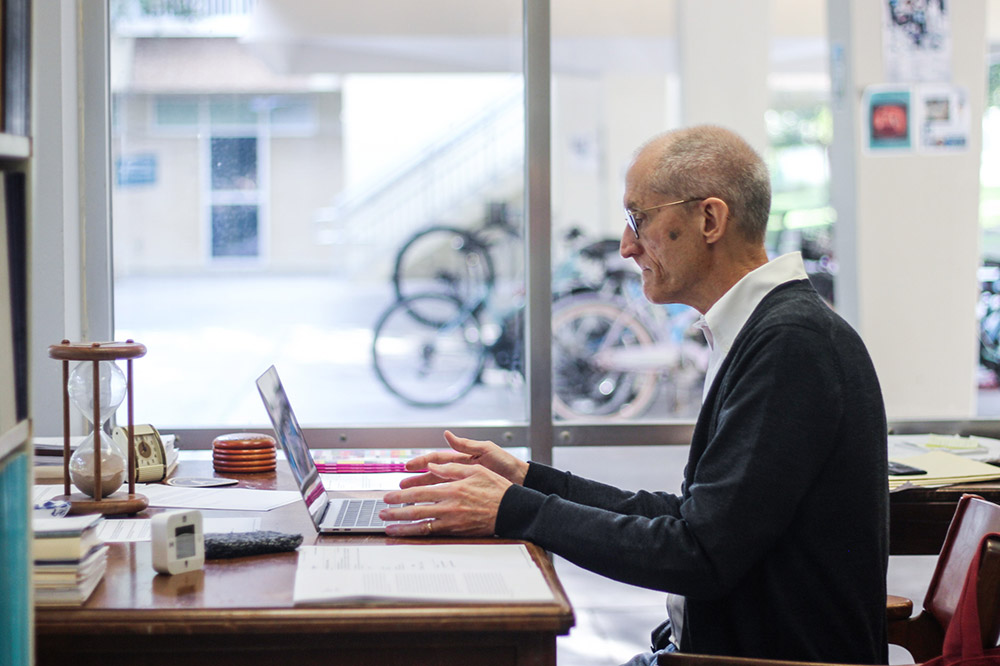
Professor of Sociology Michael Flaherty writes at his desk, seated before a sand hourglass. His upcoming book is co-written with a prison inmate who had spent more than 30 years behind bars. Photo: Angelique Herring ’19
The letter showed up in the mail. Regular mail. The kind that takes days and involves something called a postage stamp. It was from a prison inmate—a man who had spent more than 30 years behind bars for murder.
“He wrote to me in 2010 and asked if I’d like to do a book with him,” says Michael Flaherty, Ph.D., a professor of sociology at Eckerd College. “He said he’d done research on time in prison. I looked him up and found out what he was in for. I was hoping for some white-collar crime like embezzlement. But I should have known … they don’t give you a life sentence for that.”
The result of their collaboration is The Cage of Days: Time and Temporal Experience in Prison (Columbia University Press), a detailed look at what time does to prison inmates, and how the inmates try to find normalcy. The book is scheduled to be published in February and was co-written by K.C. Carceral, who uses a pseudonym and was incarcerated for 31 years in 12 different prisons. He was 19 when he was convicted of murder and given a life sentence. After his 17th parole hearing, he was released in 2013.
“I hope the book lets people know what it’s like to be in prison,” says Flaherty, who keeps an hourglass on his office desk along with two vintage clocks. One of the central messages of the book, he says, is that something as seemingly innocuous as time can be a cruel and potent weapon.
“Prisons impose strict rules,” Flaherty says. “They tell you when to sleep, wake up, eat, shower … prison is all about carefully controlling the time that prisoners have. So after a while, those controls really distort their sense of time. A day for them seems longer than a day for us because of all the repetition. If nothing is happening, every day is the same. There’s a real molasses-like quality to the whole thing.
“The techniques the inmates use, like calling a sentence a ‘spot’ or referring to 10 years as a ‘dime,’ are ingenious,” he adds. “But time in prison is excruciating and takes a toll on them.”
Flaherty, who will be teaching a new course this spring titled Prisons in American Society, says the isolations and lockdowns of the COVID pandemic provide somewhat of a glimpse into prison life. “The days blur together,” he says, “and you lose track of time.”
It gets worse. Inmates can also have difficulty making decisions. “One female inmate reports she became fearful of leaving her cell without being told to,” Flaherty says. “She lost her ability to take the initiative.”
Centuries ago, Flaherty explains, there were no prisons. People who committed crimes were either tortured or executed. “Prisons were a reform,” he adds. “But it’s punishment of the mind rather than punishment of the body. You wait for everything. Subordinate people do that. They wait for everything.”
If that’s the case, America has a lot of people waiting. “We imprison more people per capita than any other developed country,” Flaherty says. “In 2008, one out of every 100 Americans was in prison or jail. There has been a slight decrease, but it’s basically the same. The incarceration rate [the number of people in prison or jail] is 707 per 100,000 people in the U.S. It’s 148 per 100,000 in the U.K. and 77 per 100,000 in Germany.
Flaherty argues that a large increase in the number of people incarcerated in the early 1970s was a direct response to the Civil Rights Act of 1964. “It’s how we deal with racial and ethnic minorities,” he says. “Saying you’re going to get tough on crime became code for coming down on minorities.
“But Americans are good at looking away. Some say these [incarcerated] people deserve it, and we have to remember the victims of crimes. But 60 to 70% of inmates in the U.S. return to prison. Prisons assume the inmates can’t be rehabilitated, so they put no effort into it. Prisons are just schools for crime.”
But not always. Carceral, Flaherty’s co-author, has been free for eight years and today is working in the Chicago area. “But when he first got out,” Flaherty adds, “he was like Rip Van Winkle because he re-entered a very different world.”













